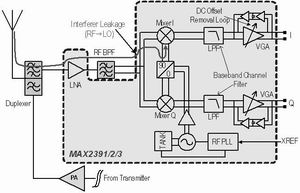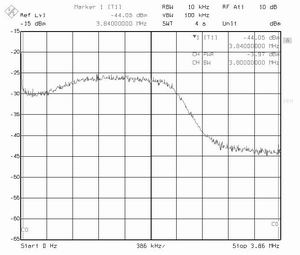In recent years, with the promotion of the third generation (3G) wireless network in Japan (IMT-2000) , Europe (UMIST) and the United States (CDMA2000) , the low cost, low power consumption and small form factor users required for 3G mobile phones Equipment (UE) becomes important. The direct down-conversion receiving structure realized by silicon technology and circuit design technology is a promising system solution for the highly integrated platform of 3G mobile phones. This article presents the commercial fully integrated zero-IF receiver solution for 3G radio ( Figure 1) . The receiver input 2nd order intercept point (IIP2) is widely discussed because it is a key performance indicator for direct conversion receivers. The measurement, simulation and calculation results are given here.

Figure 1 Direct conversion receiver IC for 3GPP FDD mobile phone radio
Â

Figure 2 2nd order intermodulation distortion caused by two -tone blocking in a zero-IF receiver
Â

Figure 3 CCDF for UL reference channel and DL 16 channel blocking
Direct conversion receiver structure
As shown in Figure 1 , the direct conversion or zero-IF receiver structure is the way to achieve complete on-chip integration of the receiver. The direct demodulation signals are the baseband I and Q signals. In 3G WCDMA FDD ( full-duplex ) operating mode, only an external duplexer is needed to separate the RX and TX parts. Moreover, a post- LAN RF filter is required in the FDD radio to suppress out-of-band blocking and transmitter leakage in the demodulator input. In the zero-IF receiver IC , the on-chip low-pass filter implements the baseband channel selection. Channel filtering follows, and the I / Q signal in the baseband is amplified by a variable gain amplifier (VGA) before being digitized by the analog baseband portion of the radio modem IC .
2nd order distortion effect
In a zero-IF receiver, the second- order intermodulation component (IM2) is an interference source, and these components in the receiver's baseband channel must be minimized. In a zero-IF receiver, after the front-end second- order nonlinear demodulation of the AM signal, the resistance differential component falls into the baseband. Since these second order IM2 component is blocked envelope consisting of a squared term, so the bandwidth of the baseband these undesirable spectral components may reach twice the amplitude of the envelope blocking bandwidth. The IM2 component depends on the desired signal modulation bandwidth in the baseband, so these IM2 components will cause part or all of the receiver interference tolerance.
The IM2 distortion component discussed here occurs in the zero-IF receiver downconverter, because the low-frequency IM2 component in the LNA is usually filtered by AC coupling or band-pass filtering between the LNA and the mixing unit . There are multiple IM2 component generation mechanisms in the zero-IF receiver . However, there are two main sources of IM2 :
RF self-mixing: This is caused by the RF signal leakage into the LO port due to the non-ideal hard switching IV characteristics and spurious coupling of the conversion stage in the mixer of the zero-IF receiver .
Downconverter RF level 2nd order nonlinearity and LO level switch mismatch: When a strong CW or modulation blockage is introduced at the input of the I / Q mixer of the zero IF receiver , the mixer transconductance or RF level active The second- order nonlinearity will produce low-frequency IM2 components.
IIP2 formula derivation
The weak nonlinear characteristics of the receiver front end can be expressed as:
∧          (1)
The receiver input signal (see FIG. 2), for the total sound power is equal to double A2 / R. The 2nd order distortion component at the front of the receiver is:
     (2)
The total output IM2 components ( including the total DC offset ) at (f1 + f2) and (f1-f2 ) are expressed as:
  (3)
The total power related to the system impedance R in the output IM2 component ( Equation 3) is calculated as follows:
           (4)
By definition, at IIP2 power level, the total input signal power is equal to the total power in the output IM2 component ( Equation 4) , divided by the gain factor | a1 | 2 can be written as:
                (5)
According to the total two-tone input power equal to P2T = A2 / R , the total power level of the IM2 component related to the receiver ( Equation 4) can be expressed as:
                              (6)
IM2 component of the total power level of 4 noted equation, which is a DC of 50% - IM2 component (3dB), the f1-f2 25% (- 6dB ) component, f1 + f2 of 25% (- 6dB ) IM2 component composition. Therefore, the power level of the IM2 component in f1-f2 can be derived from Equation 4 and Equation 6 :
(7)
Wherein the power level of each tone (f1 or f2 in the P1T) is 50% of the total two-tone power.
Effective low-frequency IM2 component
In 3GPP WCDMA wireless communication, the serious interference to the receiver input is not a two-tone type, but a wideband digital modulation blocking part. Therefore, it is very important to estimate the effective low-frequency component of the modulation block in order to obtain a receiver IIP2 that meets the performance requirements for bit error rate . This requires understanding the characteristics of modulation blocking. Especially its non-constant envelope, because it transforms the RF block to baseband, including the square term of the envelope. In the 3G standard test cases 7.3.1 and 7.6.1 , two main modulation blocking in the 3GPP WCDMA receiver are given . The first test case 7.3.1 specifies the minimum sensitivity required for BER <10-3 when the transmission uplink (UL) signal is at the maximum power level (+ 24dBm) at the antenna . The second test case 7.6.1 specifies that the minimum received signal required at the antenna connector for BER> 10-3 , the modulated downlink (DL) blocking is -44dBm , deviates from the desired signal by 15MHz , and transmits UL power at the antenna is + 20dBm .
The 3GPP standard document A.1 table shows the structure of the reference measurement channel (12.2kbps) for transmitting UL signals at the antenna of the 3GWCDMA mobile phone . It consists of a dedicated physical data channel (DPDCH) and a dedicated physical control channel (DPCCH) . In the radio modem section, both DPDCH and DPCCH channels are expanded to 3.84 Mcps , calibrated to the appropriate power ratio (DPCCH / DPDCH = -5.46dB) , HPSK coded and 1.92MHz square root cosine (RRC) filter ( roll-off factor a = 0.22 ) Filtering. In addition, the forward channel modulation block ( offset by 15MHz from the desired channel ) consists of the common channel (Table C.7 calibration ) and 16 dedicated data channels (Table C.6 calibration ) required for the test . The signal is QPSK mixed coding, extended to 3.84 Mcps , coded and filtered with RRC filter ( similar to UL signal ) . The signal- 3dB bandwidth is equal to 3.84MHz ( at RF) , and 99% of the total signal power is within the 4.12MHz bandwidth (-6dBBW) . In order to understand the envelope characteristics of modulated UL transmission signals or modulated DL16 channel signals and to estimate the effective IM2 components of these signals in WCDMA zero-IF receivers , the power statistics in each signal expressed by complementary distribution function (CCDF) are first studied . CCDF gives the peak-to-average power ratio (PAR) of the relationship between signal and probability . Figure 3 shows the ADS (Advanced Design System) simulation CCDF of UL transmission signals and DL16 channel signals .
Note that in FIG. 3 at 0.1% based on the probability of a transmission of UL DPDCH reference channel, PAR is 3.1dB. In addition, the DL blocking ( offset at 15 MHz ) containing 16 dedicated communication channels has 8.4 dB PAR ( at 0.1% probability ) , which is almost equivalent to a Gaussian noise signal. The effective low-frequency IM2 component estimation shown below is different from the two standard test cases because the PAR between the two different blocking components is different.
The simulation template of the ADS IM2 that studies the modulation and blocking of the IM2 component at the input of the WCDMA zero-IF receiver is shown in Figure 4 . The IM2 component is filtered by the RRC filter, which matches the base station transmitter RRC filter. The total low-frequency IM2 component measured in the simulation is within the desired baseband signal band of oHz ~ 2.06MHz , which is half of the 99% power bandwidth of the RF signal .
The simulated IM2 component spectrum of the WCDMA UL reference measurement channel (12.2 kbps) and the WCDMA DL 16 channel blocked at the baseband output of the frequency converter at zero intermediate frequency are shown in FIGS. 5 and 6 , respectively . In the ADS template, for simulation, a modulation blocking power of 0 dBm and a zero intermediate frequency down-converter IIP2 equal to +30 dBm are used . For the 0dBm WCDMA UL transmission signal integrated within the desired signal passband of 1KHz ... 2.06MHz , the total low-frequency IM2 component power is equal to -43.7dBm . The DC offset caused by the second- order nonlinearity is 5mV , which is equivalent to -33dBm at 50 Ω ( Figure 5) . In addition, for the power level of the total IM2 component blocked by the 0 dBm WCDMA DL 16 channel , the integral within the desired signal passband Fully Automatic Washing Machine can make your clothes more clean in a very convenient way. With PCB control, different procedures can choose more ways to wash different clothes. Nowadays fully automatic washing machines are widely used in home, hotels and laundry shops.
Our well-equipped facilities and excellent quality control throughout all stages of production enable us to guarantee total customer satisfaction. Besides, we have received CE, CB, RoHS and CCC certifications.
As a result of our high quality products and outstanding customer service, we have gained a global sales network reaching America, Asia, Europe, Africa, the Middle East and other countries and regions.
If you are interested in any of our products or would like to discuss a custom order, please feel free to contact us. We are looking forward to forming successful business relationships with new clients around the world in the near future.
3~5kg Fully Automatic Washing Machine
5Kg Fully Automatic Washing Machine,Mini Fully Automatic Washing Machine,Fully Automatic Baby Washing Machine,Small Fully Automatic Washing Machine
Ningbo Banshen Electric Appliance Co., Ltd , https://www.banshendq.com